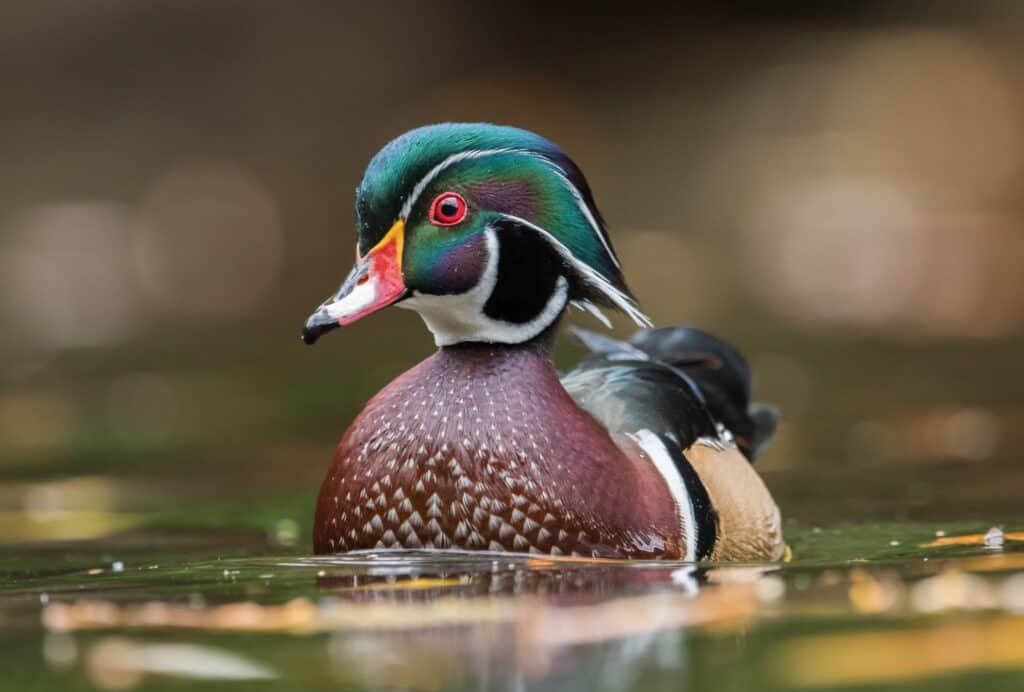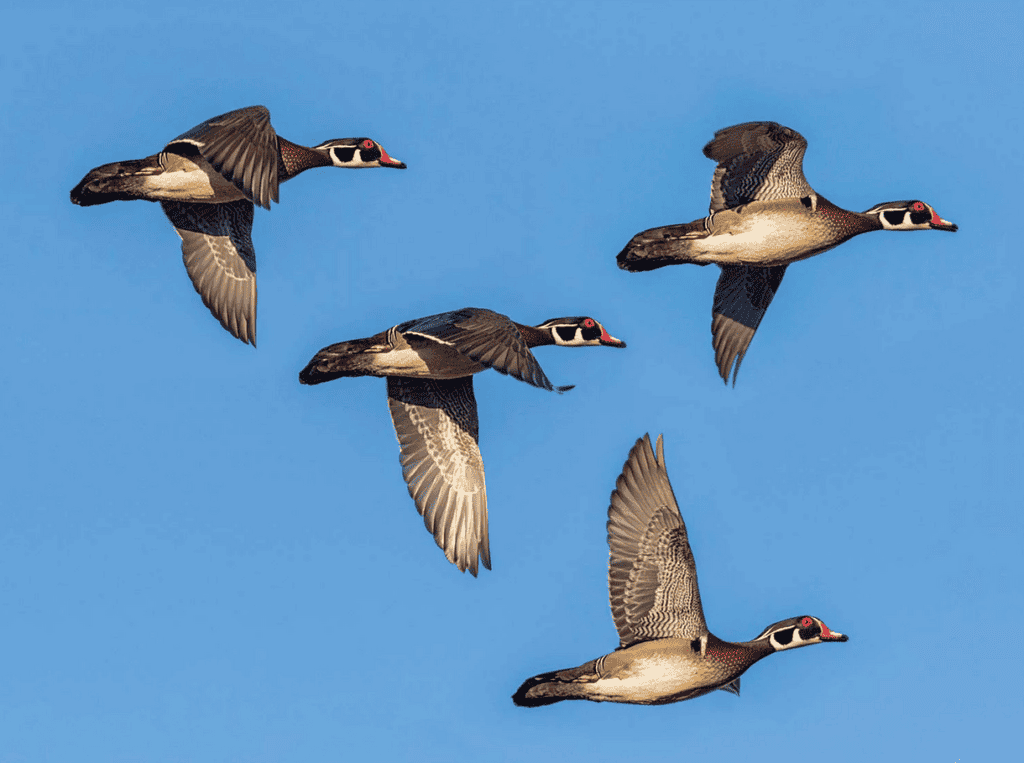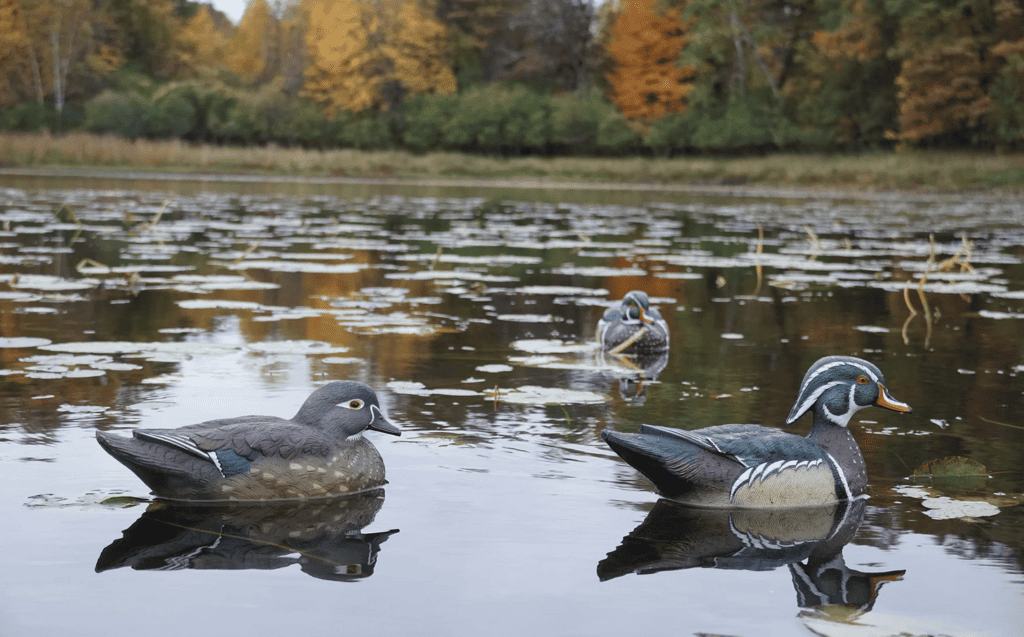Ask any waterfowl hunter in the United States what duck they think is the most beautiful; their answer is likely the wood duck. Wood ducks are beautiful ducks, and they taste great too. Many hunters enjoy hunting them, but they are often harvested opportunistically by jump-shooting or when they happen to decoy into our mallard spreads.
What if I said you can decoy them specifically? The truth is, you can! I’ve done it many times and it isn’t that hard. There are several decoy spreads and techniques you can use that will drastically increase your odds of harvesting these beautiful ducks.
Decoy Where The Ducks Will Be
The most important aspect of decoying wood ducks is being where they want to be or in other words, on the X. This is important for all waterfowl but even more so for wood ducks. You can make the best decoy spread in the world, but if you put it somewhere the ducks don’t care to be, you aren’t going to get any woodies to come in.
Wood ducks frequent small slews, streams, river oxbows, and flooded timber. They also like eating acorns. I’ve even seen them flying through the timber to oak stands. If you know of a good oak stand, look for a nearby water source and scout it early in the early morning or late evening. You should look for the ducks themselves, their feathers, and listen for their squeals.
OnX Hunt and Gaia GPS are great tools for scouting wood ducks. They will allow you to determine public vs private property and find new water sources including small creeks, marshes, and oxbows that you may never have known about. After locating the ducks, you’ll need to mark the spot and arrive before light to set up the proper spread.

How Wood Ducks Decoy
I’ve decoyed a fair number of wood ducks and I’ve noticed that they rarely come straight into a big pocket. They always seem to want to land off to the side of the decoys, or if I leave a few small pockets among the decoys, they will often land in one of those.
Further, wood ducks prefer to land next to their own species. If you have a few wood duck decoys in your spread, they will most likely land with them. Additionally, don’t put too much stock in the wind direction helping you judge where they will land. This is one of the reasons why I recommend having a few wood decoys in just about any spread. It can help out significantly with positioning wood ducks for a shot.
Wood ducks can stay up in the air and circle like mallards and other puddle ducks often will, but more times than not, they come in extremely quickly without circling multiple times. I think this is true, especially in the mornings. They either tend to come right in, or only circle a couple of times before coming down.
Lastly, wood ducks don’t always commit to land. Sometimes they just swing over or near the decoys. Be ready for a quick shot as these little ducks buzz around.
Did You Know I Had a Newsletter?! 📬
I do! I send out a weekly email that talks all about deer hunting and is a bit more personal than a regular article. If you sign up right now, I will even send you the first chapter of my Ebook “The Hunters Guide to Scent Control” for free! What is there to lose? 🙂
Pressure
Wood ducks are more likely to react negatively to pressure than other ducks. Although I have experienced multiple good shoots in an area, usually the first time you hunt an area is your best chance at harvesting a limit. Take this into consideration when scouting for new locations. Try to find new hard-to-reach or overlooked areas that other hunters don’t make it into or at least don’t hunt frequently.
Wood ducks don’t really need much water and can often be found in small pockets of river, backwaters, or potholes on the edge of marshy areas near the timber. I’ve even seen them in nothing more than a puddle in the middle of the timber.
Best Decoy Spreads for Wood Ducks
Wood ducks are often wary or nonchalant about decoy spreads. They will commonly fly by without a glance or swing by for a look just out of range and traveling pretty fast. The good news is that there are a few easy things you can do to increase your chance of bringing them in close enough for a good shot.
Small Spreads
My favorite decoy spread for wood ducks is a small one. When I’m hunting wood ducks in a little pond or swamp I use 6 to 12 wood duck decoys. Species-specific decoys seem to work very well for wood ducks. I suggest buying larger-than-life wood duck decoys to increase visibility. Plus, small spreads are nice because they can easily be packed into a decoy bag, a small boat, or even a kayak or canoe.
Another thing to think about is that wood ducks usually fly in small flocks or even in pairs or singles, so a small spread is often more realistic. If you are on bigger water, you can make a small group of wood duck decoys off to the side of your mallards, and when those pair of woodies come buzzing by, they will be more comfortable landing in that pocket you created.

Realistic Spreads
If you’ve been scouting or hunting the same place for a few years, then you’ll also have a good idea of how many wood ducks are hanging out together. If you want the most realistic spread you can have, match what you are seeing. If you are only seeing doubles or singles, try only using only a few decoys. For example, two pairs spread apart will sometimes work quite well, just remember to keep both well within shooting range.
If you are seeing a dozen birds fly around together, then use a similar number of decoys. This is likely the best technique that you can use, especially if you are specifically targeting wood ducks and aren’t hoping to just add a bonus bird to your bag.
The good thing about wood ducks–and any other duck–is that they will not mind landing in mallard decoys either. If you know most of the ducks in the area are mallards, it makes sense to have plenty of mallard decoys. Like I mentioned before though, making a little pocket of wood duck decoys is alway ways a good idea. Long story short, make your decoy spread match the type of, and the number of ducks in the area.
Big Spreads
During my first couple of years of waterfowl hunting, I experienced a phenomenal wood duck migration. I didn’t know much about duck hunting yet but experienced a literal tornado of wood ducks dumping into a local marsh. It would leave anyone with the wrong expectations for the years to come. Luckily I was in the right place at the right time to see it.
That said, it took a while for a big flock of ducks to actually come into my spread. This was likely because I didn’t have wood duck decoys and my spread probably wasn’t big enough to draw in a big flock of migrating wood ducks like that.
If you live in an area that gets large flocks of migrating wood ducks, then you should consider using a large spread of wood duck decoys during peak migration days. The large spread of wood duck decoys should be enough to entice the wary migrating birds into range. You can definitely use plenty of mallard, teal, or other decoys in there too, but if you want to bag wood ducks, your best bet is to have a healthy number of wood duck decoys.
As for how you actually spread these decoys out, when wood ducks get in large groups like that, they tend to work a lot more like mallards, and they probably aren’t coming in immediately. So instead of grouping up small numbers of decoys and letting woodies land on the outskirts of a spread like we have been doing, funnel them towards the middle. The classic U or J shaped spreads work exceptionally well for this.

If you are in a little pond like me, and you don’t have room to make a big spread like that, put a couple decoys out in the middle(or a few more depending on size), with the majority of your decoys around the edges of the water. With a little pond and a big flock, you will need some extra sauce to get woodies to come in regularly, I’ve got you covered.
Spread Additions & Movement
Nearly as important as the decoy spread itself are the techniques and additions you can add to your spread. These additions often make the difference between birds flying by outside of range or swinging in for a closer look.
Spinning Wing Decoys (Motorized and Unmotorized)
Spinning wind decoys can work really well to bring wood ducks into range. That said, they don’t always work. Sometimes they need to be placed very specifically within or even outside the spread to have the right effect.
Additionally, clouds can influence how well the spinning wing decoy works. I prefer to use them on sunny days. The flash of the wings can sometimes be a little too much on cloudy days. Nevertheless, you should always have a spinning wing decoy with you. Try setting up without it first. If the ducks don’t decoy in, add the spinning wing decoy to the setup and move it around the spread until you find a placement that works.
Battery-operated spinning wing decoys aren’t legal in all 50 states but where they aren’t, wind decoys usually are. Of course, you have to have wind for them to work, but many of them only need around a 5 mph wind to spin.
Although I would only use spinning wing decoys if you are on a larger bit of water. On a small pond or swamp, they haven’t worked out so well for me, and other much cheaper options have brought in more than enough woodies to my spreads. Let’s see that better and cheaper next!
Jerk Rigs
To me, jerk rigs are a necessity! They are very easy to use, relatively cheap (especially if you build your own), and flat-out work, especially when there isn’t much wind. To decoy wood ducks, your spread needs to look realistic and motion is key. Sometimes all you need is a little movement and a jerk rig does this nicely.
Most jerk rigs have space for up to four decoys. When running a small spread I prefer to only put one or two decoys on the jerk rig. This seems to work best for me and the ripples from the jerk rig will move the other decoys nearby. Additionally, when using a jerk rig you don’t have to constantly keep the decoys moving. A couple of pulls on the string when you see ducks is usually all it takes.
Adding that little bit of movement can really make a big difference. If you have more than a handful of wood ducks coming through, or really any kind of duck, a jerk string will take your spread to the next level and certainly help convince ducks to come down low enough for some real fun.
Swimming Decoys and Agitators
Where legal, battery-operated swimming decoys and agitators can be helpful when decoying wood ducks. Like spinning wing decoys and jerk rigs, motorized decoys help add realism to your spread. Some of these decoys are extremely realistic and may give you just enough of an edge to get small flocks of wood ducks to cup into your decoys.
Many hunters believe these decoys are better than spinning wing decoys for wood ducks. This likely depends on the area and conditions you are hunting. If you can only add one to your spread, an agitator or swimming decoy may be the better bet.
Water movement is always a good way to get ducks to come into decoys, and if you want to upgrade from the basic jerk string, an agitator is a good way to automatically make some movement. That way you only need to worry about calling and shooting, but they do cost a bit more than a jerk string.
Calling Wood Ducks
Many people believe that wood ducks can’t be called, but that couldn’t be further from the truth. You certainly can call wood ducks. You might not have the exact same response as you would with mallards, but it does work. The way I prefer to call wood ducks in is by using soft mallard quacks, feeding chuckles, and of course, wood duck calls.
Specifically, I like to make calls that sound like wood ducks sitting on the water. It is honestly my favorite call to make, and if I get off to a slow morning, then I will get going on my woodie call to wake the swamp up a little bit. With a good wood duck decoy spread, this can be mighty effective.
Here is a good video of how to make sitting wood duck sounds by Duck Commander.
Last Call
Wood ducks can be difficult to specifically target and even more difficult to decoy, but my hope is that the tips and techniques we covered above will help make you a more effective duck hunter. As all waterfowlers know, it can be an expensive lifestyle. Not everyone is going to get the latest mojo decoy that costs over $100 for a single decoy, but if you can afford to put three or four decoys on a jerk string, you will make more than enough movement.
As for the rest of your spread, make sure you are matching what you see flying. If your honey hole has a ton of wood ducks around, use a ton of wood duck decoys. If it is mostly mallards with the occasional wood duck that you would really like to bag, make most of your decoys mallards, and create a pocket or two with a few wood duck decoys in them. If you can get mallards and other ducks to come in, you shouldn’t have too hard of a time getting woodies to come in too.
Sister Post | How To Attract More Ducks To Your Pond
A sister post is another post that I have written that follows along with the same topic as the one you just read. After reading this article, you will probably like this next one even more! Here is a little teaser…
Duck hunting is easily one of the most exciting types of hunting there is, until the ducks stop coming around. We have all had spots that dry up, or a spot that doesn’t produce as well from one year to another. If that has happened to you, you are probably hoping I have a few golden nuggets for you, and luckily I do…Keep Reading
When Habitat Improvement Doesn’t Make Sense
If habitat improvement isn’t an option for you, or something you aren’t willing to do, how can you attract more ducks? Luckily, there is plenty that you can do…Keep Reading
Give Them Plenty to Eat
Being that ducks are omnivorous migratory animals that travel long distances every year, they are always on the lookout for places to land and refuel their tanks…Keep Reading
Thank you for reading my article! I hope you enjoyed it, and if you have any questions or feedback, please send me an email at [email protected]. If you want to learn more about me or Omega Outdoors, visit my About Page. Otherwise, I hope you have a great day, and check out some of my other articles while you’re here!

